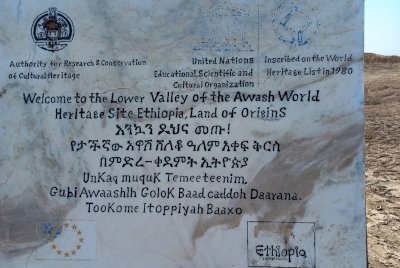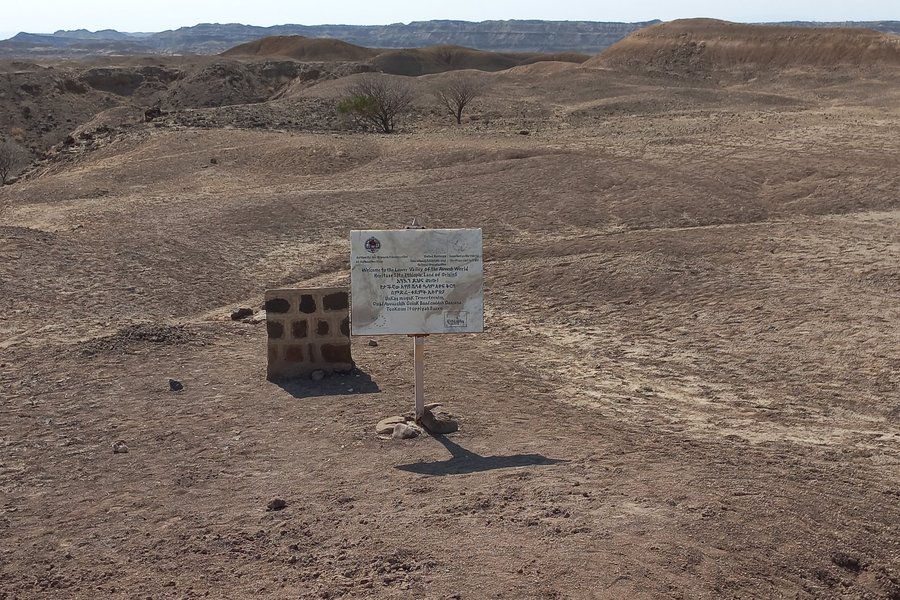Ethiopia
Lower Valley of the Awash
The Lower Valley of the Awash is one of the most important palaeontological sites on the African continent, providing evidence of human evolution.
In this valley in Ethiopia's Afar Depression, numerous pre-human hominid and animal fossils have been found, dating back to over 4 million years ago. It is also here that, in 1974, "Lucy" was found: bone fragments representing about 40% of the skeleton of an individual Australopithecus afarensis.
Community Perspective: Wojciech undertook the effort to reach this rarely visited, unspectacular place in an inhospitable area.
Site Info
Official Information
- Full Name
- Lower Valley of the Awash (ID: 10)
- Country
- Ethiopia
- Status
-
Inscribed 1980
Site history
History of Lower Valley of the Awash
- 1980: Inscribed
- Inscribed
- 1979: Deferred
- Bureau meeting - info requested in 78 still not in place
- 1978: Deferred
- Bureau meeting - info requested
- Type
- Cultural
- Criteria
- ii
- iii
- iv
Links
- UNESCO
- whc.unesco.org
- Related
-
- whc.unesco.org — NHK Video shows core zone and marker with Lucy plaque
- en.wikipedia.org — Wiki on Lucy
All Links
UNESCO.org
- whc.unesco.org — whc.unesco.org/
Related Resources
- whc.unesco.org — NHK Video shows core zone and marker with Lucy plaque
- en.wikipedia.org — Wiki on Lucy
News Article
- Aug. 26, 2025 amp.rte.ie — Human ancestor Lucy gets first European showing in Prague
Community Information
- Community Category
- Paleontology: Human evolution
Travel Information
One thousand visitors or fewer
Recent Connections
-
No Map
-
Named after a River
Awash -
Misleading WHS Names
The geographical scope is unclear due t…
Connections of Lower Valley of the Awash
- Trivia
-
-
The Beatles
"Lucy", whose discovery was the justification for inscription of this WHS, "a cquired her name from the song "Lucy in the Sky with Diamonds by the Beatles , which was played loudly and repeatedly in the expedition camp all evening after the excavation team's first day of work on the recovery site." (Wiki)
-
- History
-
-
Early Hominid Remains
'Lucy', who is estimated to have lived 3.1 million years ago.
-
- Ecology
- World Heritage Process
-
-
No Map
-
Inscribed at third attempt or more
Def 1978, Def 1979, Ins 1980
-
- Timeline
-
-
Pliocene
Lucy, 3.2 million years ago
-
- Science and Technology
-
-
Recently discovered
"The first geological explorations of the Hadar area had been done by Maurice Taieb. He apparently found Hadar in December 1970, by following one of the tributaries of the Ledi River, which originates in the highlands north of Bati to empty into the Awash River. Taeib recovered a number of fossils in the area, and led a party back to Hadar May 1972. In October 1973 the International Afar Research Expedition with 16 people arrived at Hadar and stayed there for two months, during which time the first hominid fossil was found" (Wiki). "Lucy" was discovered on 24 Nov 1974
-
- Visiting conditions
-
-
One thousand visitors or fewer
DD: Closed to tourists until at least 2001. Needs Afar permit, escort and detour. "over 650 tourists from France, Djibouti, Britain, Germany, United States, Italy, Japan and Spain visited the state [Afar] over the past seven months" (2007)See allafrica.com
-
- WHS Names
-
-
Named after a River
Awash -
Misleading WHS Names
The geographical scope is unclear due to the lack of an official map, and the site is cultural while natural is implied by focus on the Valley. Suggestion for an alternative name: ‘Hominid fossil sites in the Lower Valley of the Awash’.
-
News
- amp.rte.ie 08/26/2025
- Human ancestor Lucy gets first Eur…
Community Reviews
Show full reviews
I'm pleased to announce that another blank spot on the review map on this site is being erased. Although this WHS has its reviews, they come from people who have not visited it. Still, they were useful - thanks in particular to Solivagant for the tips.
Seeing the place where Lucy's remains were discovered takes quite an effort. The permit is still necessary, but obtaining it in Semera, according to my guide, is not difficult. Getting to the excavation site is a bit more complicated. To get there, in the village of Eli Wiha, turn towards the Awash River. A local guide is absolutely necessary (they assign him with a policeman at the police checkpoint in Eli Wiha). After exactly 44 kilometers, we reach a place that is about 200 meters from the 'road' paved by 4WD cars. People live in the area, but it is extremely inhospitable. Even in January - the coldest month - it was over 30 degrees and almost no shade. Moreover, the area is not the safest, the Afars living there are a very militant nation, almost every adult man here carries a submachine gun.
The place itself is not spectacular. Contrary to what Solivagant wrote, it is not fenced in any way. There is only commemorative plaque and a billboard with WH logo. Dozens of fossilized animal bones are falling around. I don't know their exact age, but judging by their size, they certainly do not belong to the animals currently living …
Keep reading 0 comments
In 2014 I did an organised 30 day trip through Ethiopia. Our itinerary in this region was: Kombolcha - Awash and the next day from Awash to Harar.
From Kombolcha (or Dessie) you travel around 4-6 hours on a gravel road before reaching the main Djibouti road. This is a good asphalt road. Our guid mentioned that in this area Lucy was found, but it is almost impossible to visit this site itself as there is no infrastructure between Kombolcha and Awash. You start very early and arrive at dark in Awash.
Keep reading 0 comments
Els’s count of WHS reviews implicitly presumes that anyone reviewing a site will have been there! In the case of the “Lower Valley of the Awash” this is unfortunately not so in my case. Nevertheless during our Dec 2007 visit to Ethiopia I questioned our local guide (who had visited the site on numerous occasions) quite closely about it. The information I gathered might be of interest to anyone thinking of visiting, both to help them decide whether it would be worth it, and to help them with the logistics if they do go!
As the location where the remains of the early hominid nicknamed “Lucy” were discovered, the site certainly has a world-wide significance. It is called “Hadar” and is situated south of the Danakil depression around 2-3 hours dirt road drive north of the Awash- Djibouti road near the new regional capital of Semera. Apparently it is quite “normal” to visit it as part of a 4x4 expedition into the Danakil or as a “diversion” on the way back from Lalibela to Addis.
Permission is needed from the Afar Regional State Tourism Commission in Semera. Entrance is paid to them at 50 birr per foreigner (c US$5) and a guide must be taken (cost not known). We were told that a “scout” is only needed as well if you are going on into the Danakil. This area is tribal and the sensibilities of the locals have to be assuaged by local involvement in the form of a guide …
Keep reading 0 comments